A
| a nickname for the second-to-last production shot of the day; the name was attributed to famed American production manager and assistant film director Abby Singer between the 1950s-1980s; the last shot of the day is known as the martini shot | ||
| usually refers to that part of a film's budget that covers the costs associated with major creative talent: the stars, the director, the producer(s) and the writer(s), although films with expensive special effects (and few stars) have more 'above the line' budget costs for technical aspects; the term's opposite is below the line | ||
| a type of film that rejects traditional narrative in favor of using poetic form (color, motion, sound, irrational images, etc.) to convey its meaning or feeling; aka non-linear; see also avant-garde | Examples: Rene Clair's Entr'acte (1924), Ballet Mecanique (1924), Luis Bunuel's Un Chien Andalou (1929, Fr.) | |
(absurdism) |
a stage, philosophical and literary term originally, adopted by film-makers, in which ordinary settings become bizarre, illogical, irrational, unrealistic, meaningless, and incoherent | Examples: Rhinoceros (1974) - an American Film Theatre recording with Zero Mostel and Gene Wilder, of Eugene Ionesco's 'theatre of the absurd' comedy play |
| the name given to the prestigious film awards presented each year by AMPAS (the Academy of Motion Picture Arts and Sciences, or simply 'The Academy'), a professional honorary organization within the industry, since 1927. The annual awards show, in slang, is sometimes referred to as a kudo-cast, see also Oscars | 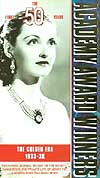 |
|
| a main division within the plot of a film; a film is often divided by 'plot points' (places of dramatic change) rather than acts; long films are divided mid-way with an intermission | ||
| (1) any movement or series of events (usually rehearsed) that take place before the camera and propel the story forward toward its conclusion; (2) the word called out (by a megaphone) at the start of the current take during filming to alert actors to begin performing; (3) also refers to the main component of action films - that often contain significant amounts of violence |  A megaphone to call out the word "ACTION" |
|
| refers either to a male performer, or to any male or female who plays a character role in an on-screen film; alternate gender-neutral terms: player, artist, or performer | 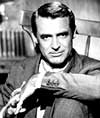 Cary Grant |
|
| refers to any female who portrays a role in a film |  Ava Gardner |
|
| the presentation of one art form through another medium; a film based upon, derived from (or adapted from) a stage play (or from another medium such as a short story, book, article, history, novel, video game, comic strip/book, etc.) which basically preserves both the setting and dialogue of the original; can be in the form of a script (screenplay) or a proposal treatment |  Who's Afraid of Virginia Woolf? (1966) is a very faithful rendering or adaptation of Edward Albee's play of the same name; also, Gone With the Wind (1939) was adapted from Margaret Mitchell's novel, and Apocalypse Now (1979) was taken from Joseph Conrad's Heart of Darkness. Who's Afraid of Virginia Woolf? (1966) is a very faithful rendering or adaptation of Edward Albee's play of the same name; also, Gone With the Wind (1939) was adapted from Margaret Mitchell's novel, and Apocalypse Now (1979) was taken from Joseph Conrad's Heart of Darkness. |
|
| a line of dialogue improvised by an actor during a performance; can be either unscripted or deliberate; improvisation consists of ad-libbed dialogue (and action) that is invented or created by the performer | ||
| a camera shot filmed in an exterior location from far overhead (from a bird's eye view), as from a helicopter (most common), blimp, balloon, plane, drone or kite; some aerial shots use miniatures, or are created with CGI (digitally); a variation on the crane shot; if the aerial shot is at the opening of a film, aka an establishing shot |
 Examples: the hunting scene in Tom Jones (1963), the helicopter raid in Francis Ford Coppola's Apocalypse Now (1979), the title card for Dr. Strangelove, Or: (1964) (see above), or the opening aerial shot of Manhattan in West Side Story (1961), of Polanski's Rosemary's Baby (1968), and in American Beauty (1999) and Mulholland Dr. (2001). Examples: the hunting scene in Tom Jones (1963), the helicopter raid in Francis Ford Coppola's Apocalypse Now (1979), the title card for Dr. Strangelove, Or: (1964) (see above), or the opening aerial shot of Manhattan in West Side Story (1961), of Polanski's Rosemary's Baby (1968), and in American Beauty (1999) and Mulholland Dr. (2001). |
|
| See typecasting | ||
| the pseudonym used by directors who refuse to put their name on a film and want to disassociate themselves, usually when they believe their control or vision has been co-opted by the studio (i.e., the film could have been recut, mutilated and altered against their wishes); aka Alan Smithee Jr., Allan Smithee, or Allen Smithee |  Examples: Death of a Gunfighter (1969), Let's Get Harry (1986), The Shrimp on the Barbie (1990), and the last film with the ironic alias: An Alan Smithee Film: Burn, Hollywood, Burn (1997). Examples: Death of a Gunfighter (1969), Let's Get Harry (1986), The Shrimp on the Barbie (1990), and the last film with the ironic alias: An Alan Smithee Film: Burn, Hollywood, Burn (1997). |
|
| usually refers to top-tier actors/actresses who are paid upwards of $20 million per feature film; can also refer to producers, directors and writers who can be guaranteed to have a film made and released | Examples: actors/actresses Tom Hanks, Julia Roberts, Brad Pitt, Jodie Foster, or directors George Lucas and Steven Spielberg | |
| mostly a literary term, but taken in film terms to mean a suggestive resemblance or correspondence between a visible event or character in a film with other more significant or abstract levels of meaning outside of the film; an extended metaphor | Examples: Metropolis (1927), Animal Farm (1955), The Seventh Seal (1957), The Piano (1993), Eat Drink Man Woman (1994), The Matrix (1999); also Biblical or Christ-related allegories. | |
| a direct or indirect reference - through an image or through dialogue - to the Bible, a classic, a person, a place, an external and/or real-life event, another film, or a well-known cultural idea | 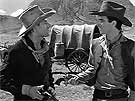 Example: In Red River (1948), Montgomery Clift (as Matt Dunson) and John Ireland (as Cherry Valance) show off their guns to each other and ask: "You know, there are only two things more beautiful than a good gun: a Swiss watch or a woman from anywhere. You ever had a good Swiss watch?" - a scene often interpreted as alluding to homosexuality Example: In Red River (1948), Montgomery Clift (as Matt Dunson) and John Ireland (as Cherry Valance) show off their guns to each other and ask: "You know, there are only two things more beautiful than a good gun: a Swiss watch or a woman from anywhere. You ever had a good Swiss watch?" - a scene often interpreted as alluding to homosexuality |
|
| the shooting (or re-shooting) of a film's ending for its theatrical release, usually enforced by the studio for any number of reasons (because of test audience preview results, controversial or unpopular subject matter, to provide a 'happy' ending, etc.). See also director's cut | Examples: The Magnificent Ambersons (1942), Kiss Me Deadly (1955), Invasion of the Body Snatchers (1956), Blade Runner (1982), Little Shop of Horrors (1986), Fatal Attraction (1987), and Army of Darkness (1993). | |
| the feeling or mood of a particular scene or setting | ||
| the natural light (usually soft) or surrounding light around a subject in a scene; also see background lighting | ||
| a situation, story-line, scene, or character, etc. in which there are apparent contradictions; an event (and its outcome) is deliberately left unclear, and there may exist more than one meaning or interpretation; can be either intentional or unintentional, to deliberately provoke imaginative thinking or confusion | Example: Robert Altman's 3 Women (1977) | |
| an element or artifact in a film that belongs to another time or place; often anachronistic elements are called film flubs | Example: Star Wars Episode II: Attack of the Clones (2002), the first feature 'film' shot using digital video cinematography, isn't really a film - an anachronistic term in this case; in the Civil War film, Glory (1989), one of the kids in the film wears what appears to be a Swatch watch; or in Lawrence of Arabia (1962), a U.S. Browning air-cooled machine gun is oddly featured before its time; or the use of 1873 Colt Peacemakers in Red River (1948) | |
| related to different optical imaging effects; refers to a method of intentionally distorting and creating a wide screen image with standard film, using a conversion process or a special lens on the camera and projector to produce different magnifications in the vertical and horizontal dimensions of the picture; an anamorphic image usually appears "squished" horizontally, while retaining its full vertical resolution; see also aspect ratio and the trade name CinemaScope. Many studios produced anamorphic lenses, using other trade names such as Panavision, Technovision, and Technirama. On the right are examples of anamorphic imaging effects from the film Blade (1998) (with an aspect ratio of 2:35.1). |
|
|
| contractual agreement in which a percentage of the profits are received by individuals, or derived from the sale of action figures, posters, CDs, books, T-shirts, etc. | 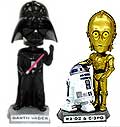 Collectible ancillary products - custom-molded, hand-painted, polyresin bobblehead dolls of the characters from Star Wars (1977). |
|
| refers to the perspective from which a camera depicts its subject; see camera angle, and other specific shots (high, low, oblique, etc.); angle on refers to directing the camera to move and focus onto a specific subject |  A camera angled slightly upward |
|
(and animator, animated films) |
a form or process of filmmaking in which inanimate, static objects or individual drawings (hand-drawn or CGI) are filmed "frame by frame" or one frame at a time (opposed to being shot "live"), each one differing slightly from the previous frame, to create the illusion of motion in a sequence, as opposed to filming naturally-occurring action or live objects at a regular frame rate. Often used as a synonym for cartoons (or toons for short), although animation includes other media such as claymation, computer animation; see also CGI, claymation, stop-motion, time lapse |
 A still from Disney's full-length animated feature film, Snow White and the Seven Dwarfs (1937). A still from Disney's full-length animated feature film, Snow White and the Seven Dwarfs (1937). Also the hand-drawn colorful laser-beams in the Star Wars films. |
|
a distinctive style of animated film that has its roots in Japanese comic books (known as manga), yet covers a wide range of genres, such as romance, action/adventure, drama, gothic, historical, horror, mystery, erotica (hentai), children's stories, although most notably sci-fi and fantasy themes; originally called 'Japanimation' but this term is not used anymore; anime is found in a wide variety of storylines and settings, but usually recognizable and often characterized by heavily-stylized backgrounds, colorful images and graphics, highly exaggerated facial expressions with limited facial movement, simulation of motion through varying the background behind a static character or other foreground element, and frequently, big-headed characters with child-like, large eyes |
 Examples: Anime began in the early 1900s, but was more developed by the 1970s, entered into the mainstream in Japan in the 1980s, and was more widely accepted internationally beginning in the 1990s. Recent examples include director Hayao Miyazaki's Princess Mononoke (1997), Spirited Away (2001) and Howl's Moving Castle (2004) (pictured). Examples: Anime began in the early 1900s, but was more developed by the 1970s, entered into the mainstream in Japan in the 1980s, and was more widely accepted internationally beginning in the 1990s. Recent examples include director Hayao Miyazaki's Princess Mononoke (1997), Spirited Away (2001) and Howl's Moving Castle (2004) (pictured). |
|
|
the main character, person, group, society, nature, force, spirit world, bad guy, or villain of a film or script who is in adversarial conflict with the film's hero, lead character or protagonist; also sometimes termed the heavy. |
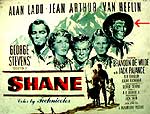 Example: Jack Palance as black-garbed, mean gunslinger Jack Wilson in Shane (1953). Example: Jack Palance as black-garbed, mean gunslinger Jack Wilson in Shane (1953). |
|
| a multi-part or multi-segmented film with a collection or series of various tales or short stories sometimes linked together by some theme or by a 'wrap-around' tale; often the stories are directed by different directors or scripted by various screenwriters, and are in the horror film genre; also known as an episode film or omnibus film; this term may also refer to a full-length, compilation-documentary film of excerpted segments or clips from other films (i.e., That's Entertainment (1974)). AKA: omnibus film or package film. See also: portmanteau film |
 Examples of true anthology films include: Creepshow (1982), a collection of five tales inspired by the EC horror comics of the 1950s, the sequel Creepshow 2 (1987), or Stephen King's Nightshift Collection (1986); also Dead of Night (1945), O. Henry's Full House (1952), Twilight Zone: The Movie (1983), Cat's Eye (1985), Tales From the Darkside: The Movie (1990), and Tales From the Hood (1995). Examples of true anthology films include: Creepshow (1982), a collection of five tales inspired by the EC horror comics of the 1950s, the sequel Creepshow 2 (1987), or Stephen King's Nightshift Collection (1986); also Dead of Night (1945), O. Henry's Full House (1952), Twilight Zone: The Movie (1983), Cat's Eye (1985), Tales From the Darkside: The Movie (1990), and Tales From the Hood (1995). |
|
| the tendency in animated films to give creatures or objects human qualities, abilities, and characteristics. |
|
|
| anything in a film, usually following the film's high point, zenith, apex, crescendo, or climax, in which there is an unsatisfying and disappointing let-down of emotion, or what is expected doesn't occur. |
 Example: the end of Fred Astaire's controversial 'blackface' tribute dance to Bill "Bojangles" Robinson in Swing Time (1936) - when he simply waves his hand dismissively and walks off stage. Example: the end of Fred Astaire's controversial 'blackface' tribute dance to Bill "Bojangles" Robinson in Swing Time (1936) - when he simply waves his hand dismissively and walks off stage. |
|
| the principal protagonist of a film who lacks the attributes or characteristics of a typical hero archetype, but with whom the audience identifies. The character is often confused or conflicted with ambiguous morals, or character defects and eccentricities, and lacks courage, honesty, or grace. The anti-hero can be tough yet sympathetic, or display vulnerable and weak traits. Specifically, the anti-hero often functions outside the mainstream and challenges it. |  Anti-hero characters in films include: Paul Newman in Hud (1963), Hombre (1967), and Cool Hand Luke (1967), Clint Eastwood's 'Man with No Name' in various spaghetti westerns and his role as 'Dirty Harry' in Dirty Harry (1971), Jack Nicholson's rebellious anti-hero in One Flew Over the Cuckoo's Nest (1975), Harrison Ford's Han Solo in Star Wars (1977), and James Dean in Rebel Without a Cause(1955). Anti-hero characters in films include: Paul Newman in Hud (1963), Hombre (1967), and Cool Hand Luke (1967), Clint Eastwood's 'Man with No Name' in various spaghetti westerns and his role as 'Dirty Harry' in Dirty Harry (1971), Jack Nicholson's rebellious anti-hero in One Flew Over the Cuckoo's Nest (1975), Harrison Ford's Han Solo in Star Wars (1977), and James Dean in Rebel Without a Cause(1955). |
|
| refers to the measurement of the opening in a camera lens that regulates the amount of light passing through and contacting the film. |  The red highlighted portion of the lens above is the aperture, which can be adjusted to either let in more or less light |
|
| a shot in which the subject(s) is photographed by an encircling or moving camera. | 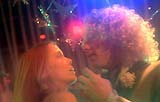 Example: the dizzying camera shot during the Carrie (1976) prom scene (pictured), or the reunion scene and embrace at the airport in Obsession (1976) Example: the dizzying camera shot during the Carrie (1976) prom scene (pictured), or the reunion scene and embrace at the airport in Obsession (1976) |
|
| a character, place, or thing, that is repeatedly presented in films with a particular style or characterization; an archetype usually applies to a specific genre or type classification. |
|
|
| French word meaning 'halt' or 'stop'; refers to the in-camera trick technique of stopping the camera, then removing or inserting an object, then restarting the camera to have an object magically disappear or appear; one of the earliest techniques of silent film | 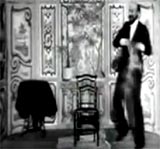 Examples: Georges Melies' The Vanishing Lady (1896) (pictured), or Edwin S. Porter's The Great Train Robbery (1903) - throwing a person/dummy off a train Examples: Georges Melies' The Vanishing Lady (1896) (pictured), or Edwin S. Porter's The Great Train Robbery (1903) - throwing a person/dummy off a train |
|
| refers to the individual (a member of the film's art department) responsible for the design, construction, look, and feel of a film's set, including the number and type of props (furniture, windows, floors, ceilings dressings, and all other set materials) and their placement |
 Example: the dark, goth moodiness and oppressive look of the set for Tim Burton's Batman (1989), created by art director Anton Furst. Example: the dark, goth moodiness and oppressive look of the set for Tim Burton's Batman (1989), created by art director Anton Furst. |
|
| a niche motion picture theater that shows foreign, low-budget, or non-mainstream independent films, often refers to films that are considered high-brow or 'art' films (see below). | ||
| films, often low budget or 'art' films, that are acknowledged as having artistic merit or aesthetic pretensions, and are shown in an art-house theatre; films shown usually include foreign-language films, independent films, non-mainstream (sometimes anti-Hollywood) films, shorts, documentaries, explicitly-erotic films, and other under-appreciated cinema of low mass appeal; began to appear in the 1950s and provided a distinct contrast to commercial films. |  Examples: La Cage Aux Folles (1978), The Sweet Hereafter (1997), Dancer in the Dark (2000), All About My Mother (1999). Examples: La Cage Aux Folles (1978), The Sweet Hereafter (1997), Dancer in the Dark (2000), All About My Mother (1999). |
|
| occurs when a character in a film breaks the 'fourth wall' and directly addresses the audience with a comment. |   Examples: Henry Hill (Ray Liotta) speaking toward the camera a few times at the conclusion of GoodFellas (1991); also the running gag of King Louis XVI (Mel Brooks) addressing the camera every time he wantonly sexually pleased himself, saying: "It's good to be the King!" in History of the World, Part I (1981) Examples: Henry Hill (Ray Liotta) speaking toward the camera a few times at the conclusion of GoodFellas (1991); also the running gag of King Louis XVI (Mel Brooks) addressing the camera every time he wantonly sexually pleased himself, saying: "It's good to be the King!" in History of the World, Part I (1981) |
|
| in general, a term for how the image appears on the screen based on how it was shot; refers to the ratio of width (horizontal or top) to height (vertical or side) of a film frame, image or screen; the most common or standard aspect ratio in early films to the 1950s was called Academy Aperture (or ratio), at a ratio of 1.33:1 (the same as 4:3 ratio on a non-widescreen TV); normal 35mm films are shot at a ratio of 1.85:1; new widescreen formats and aspect ratios were introduced in the 1950s, from 1.65:1 and higher;CinemaScope (a trade name for a widescreen movie format used in the US from 1953 to 1967) and other anamorphic systems (such as Panavision) have a 2.35:1 AR, while 70mm formats have an AR of 2.2:1; Cinerama had a 2.77:1 aspect ratio; letterboxed videos for widescreen TV's are frequently in 16:9 (or 1.77:1) AR. |  An example of an aspect ratio of 16:9 (or 1.77:1). Any number of films to the 1950s could be examples. |
|
| the first stage or step of editing, in which all the shots are arranged in script order. | ||
| refers to audio-track sounds that are mismatched or out of conjunction or unison with the images in the visual frame (or screen); sometimes accidental, but sometimes intentional; aka non-synchronized | ||
| refers to any concrete or nebulous quality or feeling that contributes a dimensional tone to a film's action. | Examples: spookiness, howling wind, searing heat, blinding light, a rain downpour, etc. | |
| refers to spectators, viewers, participants - those who serve as a measure of a film's success; although usually audiences are viewed in universal terms, they can also be segmented or categorized (e.g., 'art-film' audiences, 'chick film' audiences, etc.). |  Audience members |
|
| refers to the sound portion of a film. | Audio clip: |
|
| refers to an outgoing sound (either dialogue or sound effects) in one scene that continues over into a new image or shot - in this case, the soundtrack, not a visual image, connects the two shots or scenes; aka lightning mix | Examples: many examples in Citizen Kane (1941)and also in Apocalypse Now (1979) - the sound of helicopter blades are linked to the next scene of the spinning blades of an overhead fan | |
| the process whereby an actor-performer seeks a role by presenting to a director or casting directora prepared reading or by 'reading cold' from the film script, or performing a choreographed dance; after the initial audition, a performer may be called backfor additional readings or run-throughs. |  Example: Auditions for "Ah, The Moon Is Here" for producer Chester Kent (James Cagney) in Footlight Parade (1933) Example: Auditions for "Ah, The Moon Is Here" for producer Chester Kent (James Cagney) in Footlight Parade (1933) |
|
(or auteur theory) |
literally the French word for "author"; in film criticism, used in the terms auteurism or auteur theory, denoting a critical theory (originally known as la politique des auteurs or "the policy of authors") popular in France in the late 1940s and early 1950s that was introduced by Francois Truffaut and the editors (including legendary film critic and theorist Andre Bazin) of the celebrated French film journal Cahiers du Cinéma (literally 'cinema notebooks'), arguably the most influential film magazine in film history; their ideas were subsequently enlarged upon in the 1960s by American critic Andrew Sarris, among others; the theory ascribed overall responsibility for the creation of a film and its personal vision, identifiable style, thematic aspects and techniques to its film-maker or director, rather than to the collaborative efforts of all involved (actors, producer, production designer, special effects supervisor, etc); the theory posited that directors should be considered the 'true' authors of film (rather than the screenwriters) because they exercise a great deal of control over all facets of film making and impart a distinctive, personal style to their films; simply stated, an auteur can refer to a director with a recognizable or signature style. |
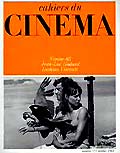 Cover from early edition of the French film review journal Cahiers du Cinema. 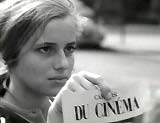 (From auteur Jean-Luc Godard's Breathless (1960, Fr.)) |
| the naturally-existing light in an off-set location; a film's realism is enhanced by using available or natural light rather than having artificial light. | ||
| refers to an experimental, abstract, or highly independent, non-independent film that is often the forerunner of a new artistic genre or art form; avant-garde films self-consciously emphasize technique over substance; also loosely applies to a group of French and German filmmakers in the early 20th century and to some modern American experimental filmmakers (e.g., Andy Warhol), and their film movement that challenged conventional film-making; see also cinema verite, surrealism, and abstract form |  Example: American pop artist Andy Warhol produced/directed Sleep (1963), The Chelsea Girls (1967), Flesh (1968), Lonesome Cowboys (1968), Trash (1972), and Women in Revolt (1971). Example: American pop artist Andy Warhol produced/directed Sleep (1963), The Chelsea Girls (1967), Flesh (1968), Lonesome Cowboys (1968), Trash (1972), and Women in Revolt (1971). |
|
| an imaginary or invisible line (or axis) that passes through two main subjects being filmed in a scene, who face each other (one is left, the other is right); conventionally, the camera must maintain that left-right relationship or orientation in order to avoid disorienting or distracting the viewer with a reverse angle shot (although sometimes this effect is intentional); see also 180 degree rule | ||
źródło:www.filmsite.org





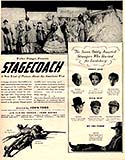 Examples: the whore with a heart of gold and the many other disparate characters on the trip to Lordsburg in
Examples: the whore with a heart of gold and the many other disparate characters on the trip to Lordsburg in